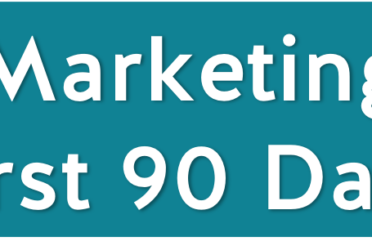The first 90 days – building the foundation: such a pivotal and exciting time in the marketing journey at a startup. I have been through it quite a few times and seen both successes and flops. Here are the lessons I learned organized in a three-post series.
- Introduction – Assessing Company Stage – Culture – Lean Canvas
- Positioning Framework: Segmentation – Personas – Point of View
- Elevator Pitch – Solution – Discovery and Qualification – Sales deck – Roadmap – Enablement
Ultimately the goal of marketing is to generate demand and accelerate the customer journey towards a buy decision. The foundation for this in the first 90 days is to define a clear strategy and message:
- Align marketing, sales, and products under a cohesive strategy
- Develop and enable everybody in the company to tell a consistent and compelling story
This is not something you do once and then forget about. It is an on-going iterative process, but you need a baseline, an initial set of well articulated hypothesis that get validated, refined, and sometimes totally changed with a pivot.
I had an ideal, though unconventional, preparation for marketing in my first career as a stage painter for operas in Italy. Think about it: emotionally engaging stories; using perspective to compress the visual of large spaces onto a small stage for maximum impact; and working with super creative people on crazy deadlines! Sounds familiar?
Company stage and culture
When getting started it’s tempting to dive straight into the “how” – into execution, but I have found it critically important to first understand the specific stage a company is at, assess its culture and dynamics, and focus first on the “why” and “what”.
I have seen startups in three main stages:
- Brand new product – this is the ground floor and the focus is on rapid iterations to find who the customer is and what is the business pain we solve. Early prototypes and rapid feedback cycles are the approach.
- Everything for everybody – a product looking for a problem. Sales presentations are an onslaught of features (throwing spaghetti on a wall) in the hope that one will hit a relevant pain point for the customer. The key here is to convince founders that it’s ok to say NO to something, and that we need to focus and go from generic toolkit for everybody to a solution to a precise problem for a specific audience.
- Flattened growth – initial success with early adopters has slowed down. Original hypothesis need to be reassessed to find a new focus on an adjacent market, or shift to a different vertical and/or pain point.
In all three cases being close to customers to understand their reality has served me well.
Culture and dynamics have a big impact on how to go about making things happen. I love highly collaborative teams where everybody contributes and engages in innovation, and founders are open to new ideas. Things move fast and everybody feels ownership in what is being created. At the other end of the spectrum I also experienced organizations where every contribution was critically dissected and people judged for it. Needless to say this hinders the flow of innovation. In this type of setting, time needs to be allocated to build support for ideas and avoid being broadsided in meetings. A pity, because it takes longer to get things done and one has to watch her back all the time. The my-way-or-the highway is another unfortunate scenario I have run into. Here you have a founder who does not tolerate input that is perceived as a criticism or invalidation of their leadership – regardless of the intention. The only way to succeed is to present in private multiple options, so that the founder can choose or discard them and the selected approach then becomes his idea.
Regardless of stage and culture here are the key 90 day deliverables that have supported me in producing the desired outcomes of alignment and compelling message:
- Lean canvas – the business in one page
- Positioning framework – market segmentation, value proposition, and message
- Short slide deck – 10 slides to communicate the story
- Product strategy and roadmap – aligning value proposition and vision to product priorities
- Enablement – socialize and train everybody in the company of the new strategy and message
Next I will describe each of the deliverables, why they are important, and what I found helpful to getting them done.
- Lean canvas
A lean canvas is a summary of the business in one slide. The beauty of it is that it forces us to condense down to the essence what we are doing and why. Yes, it’s a painful process, but it pays back in spades because it’s a powerful way to communicate what we are about and get alignment.
I start this right away and it always takes many iterations to refine it, so I work on it in parallel with the other deliverables.
Different people and companies use different sets of components in a lean canvas. I like to use these eight components – each must be conveyed in one or two short sentences.
- Offering vision – What we are doing and why.
- Target customer – Who exactly are we selling to, what is their role and in what type of company to they work.
- Customer pain/needs – What is the main business pain we are addressing for the target customer.
- Alternatives – What options does the target customer have to solve the pain we are addressing.
- Sustainable competitive advantage – As other vendors catch up with us, what will give us a sustainable advantage.
- Pricing strategy – What’s our pricing model.
- Focus areas and key metrics – For the immediate future, what are relentlessly focused on and how do we measure success.
- Portfolio role – If we have more than one product, in which portfolio horizon is this product.
Lean canvas example for a startup pivot in the continuous software delivery as a service market:
| Offering vision | Cut by 30-50% the time to integrate, test, and deploy software.
Orchestration to automate the continuous delivery process and the required resource provisioning. |
| Target customer | Dev and devops managers in software organizations with multi-component applications striving for continuous integration and deployment. |
| Customer pain/need | Can’t keep up with pace of changes, and quality is inconsistent. Required infrastructure resources are not readily available. Top developers spend too much time writing operational tools instead of creating code. |
| Alternatives | Collection of tools and in house scripts to tie together VC, build, and CM tools. VM’s and public Clouds. |
| Sustainable competitive advantage | Time to value thru built-in best practices and templates.
Network effect as platform of choice that other tools plug into. |
| Pricing Strategy | Number of deployment pipelines plus cloud resource consumption. |
| Focus areas & key metrics | Validate high-level hypothesis, outline MVP. Focus on best practices, UX, and integrations. Metrics: Interviews with dev/test and dev/ops people. Responses to message and prototype. Time to MVP. |
| Portfolio role | Straddles Horizon 2 (extending current offering) and 3 (new offering) |
##########
The next blog in this three-post series covers:




Leave a Reply